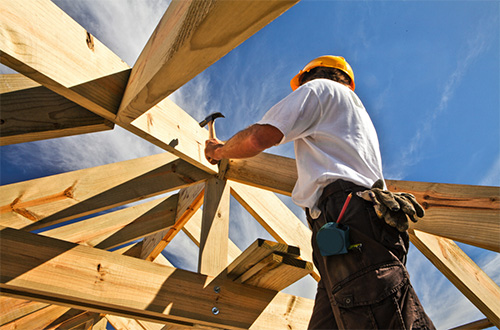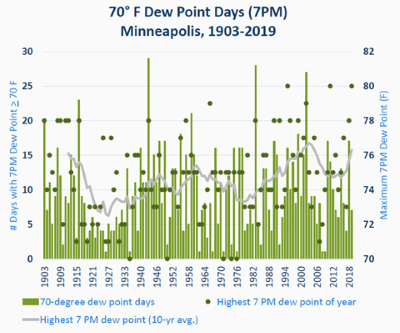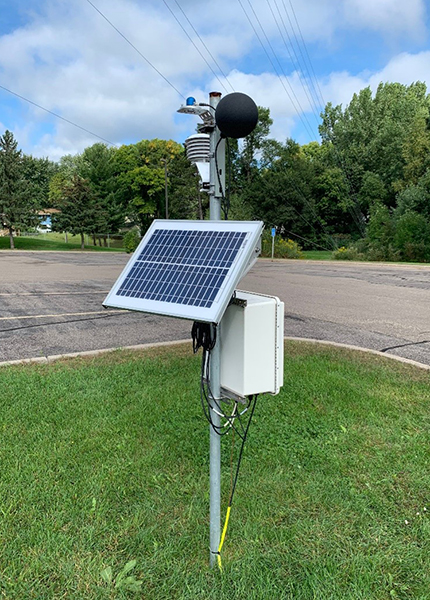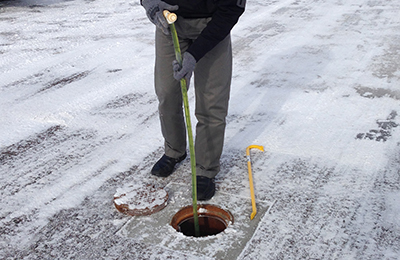How climate change is impacting summer heat
 When we experience hot days in the summer, it can be easy to think that climate change is causing those high temperatures. However, a more detailed understanding of climate science is needed to understand the true impact that climate change is having on our summers.
When we experience hot days in the summer, it can be easy to think that climate change is causing those high temperatures. However, a more detailed understanding of climate science is needed to understand the true impact that climate change is having on our summers.
Hennepin County Emergency Management conducts research and monitors weather trends to identify long-term climate trends impacting Hennepin County, understand who is most impacted by these trends, and help people be prepared for extreme weather.
Increased humidity is driving an increase in extremely hot days
Kenny Blumenfeld, a climatologist and hazardous weather and climate researcher with Hennepin County Emergency Management, is helping increase our understanding of the impact climate change is having on summer heat. Temperature and humidity data going back to 1903 was analyzed to understand current and future climate trends.
Although it might feel like our heat has gotten more extreme, climate change so far has not made our summers hotter. Specifically, the number of hot days (days with a maximum temperature of 90 °F or higher) has not increased, our hottest days have not gotten hotter, and heat waves (three or more consecutive hot days) have not become more common. However, climate trends suggest that we are likely to see hotter days and more extreme heat waves due to climate change in the coming decades.
 The research has uncovered a trend that is making our hot days more uncomfortable and dangerous: increased humidity. Days that are extremely humid are becoming more common and more extreme. In fact, most of the highest dewpoints (which is a good measure of how humid it feels) on record have occurred since 1990. This is concerning because the body’s ability to evaporate sweat is limited on extremely humid days, making it harder to cool off.
The research has uncovered a trend that is making our hot days more uncomfortable and dangerous: increased humidity. Days that are extremely humid are becoming more common and more extreme. In fact, most of the highest dewpoints (which is a good measure of how humid it feels) on record have occurred since 1990. This is concerning because the body’s ability to evaporate sweat is limited on extremely humid days, making it harder to cool off.
This trend is illustrated by the graph showing the number of days each year with a 70-degree F dewpoint. Although there is variability from year to year, the gray trend line shows that the number of days with extreme humidity each year has been slowly increasing.
Who is most impacted by extreme heat and humidity
 The impact of heat and humidity depends on a person’s capacity to respond, where they live, how much they need to be outside, and their ability to access air conditioning. A key goal of Hennepin County’s Climate Action Plan is protecting residents most vulnerable to climate change, so understanding these disproportionate risks and impacts is important.
The impact of heat and humidity depends on a person’s capacity to respond, where they live, how much they need to be outside, and their ability to access air conditioning. A key goal of Hennepin County’s Climate Action Plan is protecting residents most vulnerable to climate change, so understanding these disproportionate risks and impacts is important.
For many residents, extreme heat and humidity may translate only to higher utility bills resulting from increased use of air conditioning. Hot and humid days disproportionately affect residents with underlying health conditions and people who work or exercise outside. People without access to air conditioning and those who live in urban areas face even higher risks, because hard surfaces and less tree canopy make hot days even hotter. This is what is referred to as the urban heat island effect.
Extreme heat and humidity become especially dangerous when temperatures stay above 70 °F at night. Existing physical and mental health stressors worsen when people cannot cool off at night due to lack of access to air conditioning or cooling options.
We know that many Black, Indigenous, and people of color, especially in areas that were historically redlined, face higher risks from heat and humidity because they are more likely to live in urban areas where more pavement and less tree canopy create higher temperatures.
People experiencing homelessness also face higher risks. About half of the deaths that occur from extreme heat and humidity in the U.S. are people experiencing homelessness. Black and Indigenous people disproportionately experience homelessness in Hennepin County.
Additionally, people with certain health conditions and on certain medications may be at increased risk during extreme heat and humidity. This includes people with high blood pressure, heart disease, and mental health conditions like depression and schizophrenia.
To help people take needed breaks during extreme heat and humidity, Hennepin County maintains a map of cooling options at hennepin.us/cool.
Wet bulb globe temperature helping people understand impacts of heat and humidity
 Hennepin County has partnered with the National Weather Service to improve warnings for extreme heat stress using a measurement called Wet Bulb Globe Temperature. This measurement helps people spending time outdoors better understand how heat might impact them.
Hennepin County has partnered with the National Weather Service to improve warnings for extreme heat stress using a measurement called Wet Bulb Globe Temperature. This measurement helps people spending time outdoors better understand how heat might impact them.
Currently, the most recognized way to understand heat is the heat index, which takes into consideration air temperature and relative humidity. For people only going outside briefly during hot days, the heat index will help you understand how hot it will feel.
The Wet Bulb Globe Temperature is a calculated measure of heat stress in direct sunlight that considers air temperature, relative humidity, wind speed, solar radiation, and sun angle. These factors all relate to the body’s ability to cool itself in direct sunlight.
To help calculate the Wet Bulb Globe Temperature, Hennepin County has a black globe sensor at every Hennepin West Mesonet site in Hennepin County. A mesonet is a station of automated weather sensors used to measure local weather conditions, and the county’s dense network of mesonet station greatly helps improve our understanding of local weather conditions.
Find current wet-bulb globe temperatures from Hennepin County and the National Weather Service on the Hennepin West Mesonet. This information helps people working or exercising outdoors on hot and humid days plan ahead and take necessary breaks to stay safe.


